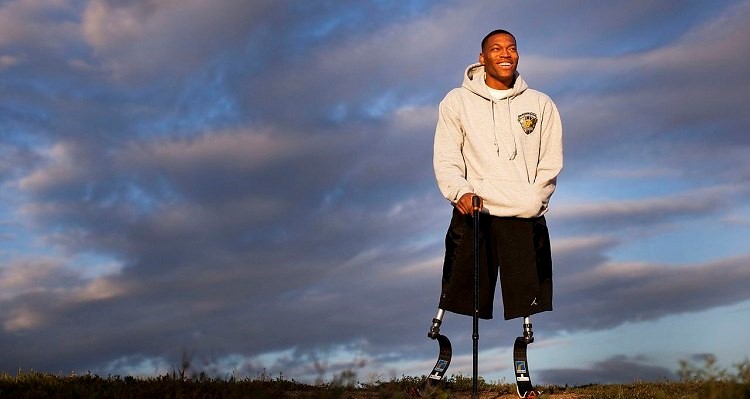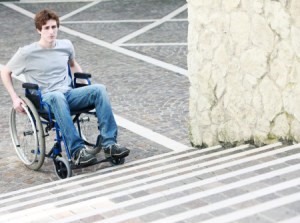Men and disability – Part 1
Men and disability – Part 2
Men and disability – Part 3

As with parenting and school education, the disability sector is overwhelmingly managed and staffed by women. They are the nurses, community support workers, personal care assistants, physiotherapists, guidance counselors and so on. That domination ensures women’s views about gender govern the provision of services for most disabled men. Before discussing the problems created by this skewed situation, let’s begin with a look at the rise of the disability rights movement.
Although disability issues received varying levels of attention throughout history, they became an international cause célèbre from 1960s, this on the tail of the black civil rights movement in America, and coinciding with the rise of second wave feminism. This generated nothing short of a revolution in awareness about the lives and needs of people with disabilities.
The disability rights movement helped to secure greater access to the social and physical environment, as well as opportunities for independent living, employment, education, and housing. It also promoted freedom from abuse, neglect, and other violations, and the establishment of civil rights legislation to secure these opportunities and rights.
So far so good. However in recent years the movement has suffered mission-creep into the arena of gender politics. We are now more likely to hear about domestic violence and sexual assault against disabled women, their wage discrimination and other forms of double-disadvantage, while contrasting them with the depravity, privilege, rapiness and violence-proneness of disabled men — a narrative fostering denial of vulnerabilities men may face along with a demonizing of men to boot.
It’s a growing problem that needs to be stopped.
I’m not suggesting we should stop paying attention to issues like sexual assault and abuse against women, which absolutely must be addressed for this vulnerable demographic. But we needn’t demonize men and boys as the default perpetrator class, nor discriminate against them which we do by refusing to recognize males as victims of abuse and by dismissing or silencing those who might speak about it.
I know dozens of disabled men who have suffered serious violence or sexual abuse who have been afraid to tell someone for fear of being disbelieved, blamed or ridiculed. Marginalizing the issues of disabled men in the service of a one-sided gendered approach ultimately undermines the good work of the disability rights movement during the last 50 years – it shifts the focus from a humanitarian movement to a largely sexist one from within its own culture.
The gynocentric approach is compounded by the fact that most workers in the sector are women, who understandably have a more empathic appreciation of women’s concerns than men’s. The existence of female bias in the disability sector can be stressed in the following way: many women possess an inadequate understanding of the experiences and concerns of men with disabilities.
Poorly educated female workers, ie. those providing most of the frontline services, tend to rely on male stereotypes to guide their understandings of clientele, imposing the usual boilerplate images of males as utilitarian, rough, insensitive, sport obsessed, sex-obsessed, and so on. That vision is devoid of deeper knowledge of men generally, is at variance to the individuality of males specifically, and it tends to dictate the tone of care.
At this point readers may feel I’m being a little hard on female disability workers, which is correct. More accurately I’m being hard on the current culture of disability services because of the growing gynocentric trend, and pointing to an area of potential improvement in service provision. To be fair, I have no hesitation in admitting the existence of excellent female disability workers who do understand men’s issues and provide a very high quality of support, but these are more often the exception rather than the rule. This article however is attempting to show where disability services are failing in their duty of care for men, and the increasing gynocentric culture is, at least to my thinking, the area of greatest failure.
Having worked in the disability field for 30 years, I’ve had more opportunity than most to observe the provision of services to men. The following are six areas where gender stereotyping is failing men with disabilities.
1. Men do, women are
In a recent article I described how men are considered utilities or ‘action men’ expected to be of service to others.1 The expectation is sadly no different for disabled men, and one of the first things female support workers often do is put him to work doing odd jobs and showing him how to be ‘useful’ to women and society. A woman with an identical disability will often get asked a different set of questions – like what do you want to do to have fun.
2. Male aggression or violence is an attempt to dominate
Both men and women with disabilities sometimes find life frustrating and lash out in anger. Typically males are lectured about how their aggression upsets other people, causes damage to the wider world, and are instructed on how to control their anger – while the disabled woman who lashes out in the same manner is calmed and asked what or who is bothering her and perhaps how the world might be rearranged so that it doesn’t upset her again. Disability support workers are less likely to consider the real distress or powerlessness that causes men to lash out.
3. Males are rarely victims of violence
Government media campaigns focusing solely on “violence against women” have encouraged the assumption that men are default perpetrators who don’t suffer violence. The belief among support workers that disabled men are safe from violence has created an environment in which abused men are less likely to speak up and seek help… there is no encouragement to do otherwise. Despite the fact that U.S. Department of Justice has reported violence crimes against disabled men and women at roughly equal rates,2 a Google search for information delivers the following disparity of awareness:
- “Violence against disabled women” = 4330 results.
- “Violence against disabled men” = 9 results.
4. Males are unlikely to suffer sexual abuse or rape
As with men in prisons who experience high levels of sexual assault, disabled males are four times more likely than nondisabled men to be sexually assaulted or raped.3 The researchers of that study found that more than 5 percent of disabled men reported experiencing sexual assault during the past year, about equal to sexual assaults against disabled women.3
If ‘rape culture’ is based in social invisibility and voicelessness of a victim group, then disabled men are dealing with a legitimate rape culture – one entrenched by the people who receive a weekly pay-cheque to help lift that silence. Again a Google search speaks volumes:
- “Sexual violence against disabled women” = 1520 results.
- “Sexual violence against disabled men” = 0 results.
5. Men are less in need of assistance than women

Patriarchy makes climbing stairs in a wheelchair easy?
As addressed in part one, disabled men are deemed privileged by patriarchy while women with disabilities are considered doubly disadvantaged by the same. The gynocentric privileges historically afforded to women have not yet entered the discourse – such as being recipients of living expenses drawn from male labor, or receiving greater provision and protection generally. Gynocentric prioritization is further underlined in phrases like “damsel in distress,” “ladies before gentlemen,” “girls before boys” or “ladies first,”, which are codes of chivalric and gentlemanly behavior that place disabled men in second place on the basis of their sex.
The stereotype of the cigar-smoking, brandy swilling patriarch, in combination with the custom of “ladies first,” sees that men are at a disadvantage to women in the fight for limited disability services.
6. Male sexual needs are socially unacceptable
Men’s sexual desires are gross and in need of suppressing or civilizing, so think some individuals charged with supporting men with disabilities. Cultural narratives characterizing male sexuality as dirty, violent and oppressive are clearly toxic to male self-image, however some among the mostly female workforce have adopted that negative mindset and with it created barriers to men’s attempts to enjoy healthy sexual expression.
When a disabled man desires a woman, or masturbates, or perhaps decides to hire a prostitute – all natural behaviors – female support workers tend to be unsupportive, believing sexual desires must be tamed in the service of something more civilized such as nonsexual dating and romantic love.
I have observed female staff match-make male and female clientele — treating them like Barbie & Ken in a child’s dolls house — while also instructing men in the arts of non-sexual chivalry, such as bringing gifts and flowers for a potential girlfriend or perhaps taking her to a romantic restaurant while the support worker plays hostess. While perhaps well meaning, my reading of such intervention is that it leaves out many aspects of male nature, especially male sexual needs, in favor of gynocentric themes which is ultimately an insult to the men in question.
. . .
These are just a few examples of biases men with disabilities face. Problems generated by gynocentrism and misandry within the disability sector (and beyond) are sometimes blatant and at other times subtle, but in either case they are mostly unrecognized and unquestioned by those on the front lines of service provision.
Men with disabilities receive little more empathy than their able-bodied counterparts – and in some respects they receive less. As with all men’s issues, from health funding to prostate cancer, birth control options, or homelessness, men are going to have to speak up – in fact they are going to have to shout up. Those in power might not see men’s pain, but they will hear men’s anger.
This leads to the next article in this series where we will look at a new kind of man with a disability – he is the one who says “No” to gynocentrism and other forms of mistreatment, and acts decisively to shut them down.
References
[1] Peter Wright, Don’t just do something, SIT THERE (June 2015)
[2] Harrell, E., Rand, M., Crime Against People with Disabilities, U.S. Department of Justice (2008)
[3] Mitra, Monika, Vera E. Mouradian, and Marci Diamond. Sexual Violence Victimization Against Men with Disabilities, American Journal of Preventive Medicine (2011)
Feature image: Cpl. Anthony McDaniel
You must log in to post a comment.